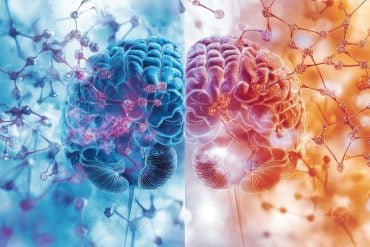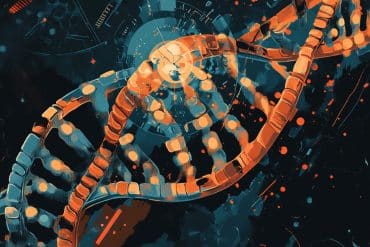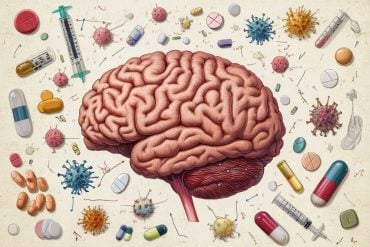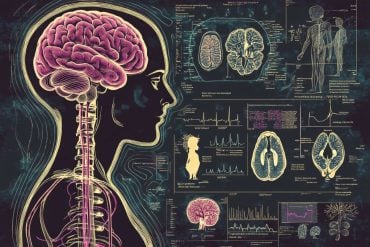After a debate that has lasted more than 130 years, researchers at Georgetown University Medical Center have found that loss of speech from a stroke in the left hemisphere of the brain can be recovered on the back, right side of the brain. This contradicts recent notions that the right hemisphere interferes with recovery.
While the findings will likely not put an immediate end to the debate, they suggest a new direction in treatment.
The study, published online in Brain, is the first to look at brain structure and grey matter volume when trying to understand how speech is recovered after a stroke. Results show that patients who have regained their voice have increased grey matter volume in the back of their right hemisphere — mirroring the location of one of the two left hemisphere speech areas.
“Over the past decade, researchers have increasingly suggested that the right hemisphere interferes with good recovery of language after left hemisphere strokes,” says the study’s senior author, Peter Turkeltaub, MD, PhD., an assistant professor of neurology at Georgetown University Medical Center and director of the aphasia clinic at MedStar National Rehabilitation Network. “Our results suggest the opposite — that right hemisphere compensation improves recovery.”
Approximately one-third of stroke survivors lose speech and language — a disorder called aphasia — and most never fully regain it. Turkeltaub says loss of speech occurs almost exclusively in patients with a left hemisphere stroke — roughly 70 percent of people with left hemisphere strokes have language problems.
In a group of 32 left-hemisphere stroke survivors, the researchers determined whether increased grey matter volume in the right hemisphere related to better than expected speech abilities, given the individual features of each person’s stroke. The researchers enrolled an additional 30 individuals who had not experienced a stroke as a control group.

The investigators found that stroke participants who had better than expected speech abilities after their stroke had more grey matter in the back of the right hemisphere compared to stroke patients with worse speech. Those areas of the right hemisphere were also larger in the stroke survivors than in the control group, Turkeltaub says. “This indicates growth in these brain areas that relates to better speech production after a stroke.”
Turkeltaub, a member of the Center for Brain Plasticity and Recovery at Georgetown University and MedStar National Rehabilitation Network, and his colleagues are continuing their study, looking for areas that compensate for other aspects of language use, such as comprehension of speech. The speech center discovered by the team aids only in use of speech, not in understanding what is said to an affected stroke patient.
Co-authors include Shihui Xing, MD, PhD, Elizabeth H. Lacey, PhD, Elizabeth Lacey, PhD, Xiong Jiang, PhD, and Laura M. Skipper-Kallal, PhD, from Georgetown University Medical Center; Michelle Harris-Love, PhD, from MedStar National Rehabilitation Network and a member of the Center for Brain Plasticity and Recovery; and Jinsheng Zeng MD, PhD, from First Affiliated Hospital of Sun Yat-Sen University in Guangzhou, China;
Funding: This study was supported by the National Center for Advancing Translational Sciences via the Georgetown-Howard Universities Center for Clinical and Translational Science (KL2TR000102), Doris Duke Charitable Foundation (2012062), Vernon Family Trust, National Natural Science Foundation of China (81000500, 81371277), Joint Funds of the Natural Science Foundation of China (U1032005), Project of Science and Technology New Star of Pearl River (2012J2200089), Chinese Government Scholarship Program, and Alzheimer’s Drug Discovery Foundation (20130805).
Source: Karen Teber – Georgetown University Medical Center
Image Source: The image is credited to BruceBlaus and is licensed CC BY 3.0
Original Research: Abstract for “Right hemisphere grey matter structure and language outcomes in chronic left hemisphere stroke” by Shihui Xing, Elizabeth H. Lacey, Laura M. Skipper-Kallal, Xiong Jiang, Michelle L. Harris-Love, Jinsheng Zeng, and Peter E. Turkeltaub in Brain. Published online October 31 2015 doi:10.1093/brain/awv323
Abstract
Right hemisphere grey matter structure and language outcomes in chronic left hemisphere stroke
The neural mechanisms underlying recovery of language after left hemisphere stroke remain elusive. Although older evidence suggested that right hemisphere language homologues compensate for damage in left hemisphere language areas, the current prevailing theory suggests that right hemisphere engagement is ineffective or even maladaptive. Using a novel combination of support vector regression-based lesion-symptom mapping and voxel-based morphometry, we aimed to determine whether local grey matter volume in the right hemisphere independently contributes to aphasia outcomes after chronic left hemisphere stroke. Thirty-two left hemisphere stroke survivors with aphasia underwent language assessment with the Western Aphasia Battery-Revised and tests of other cognitive domains. High-resolution T1-weighted images were obtained in aphasia patients and 30 demographically matched healthy controls. Support vector regression-based multivariate lesion-symptom mapping was used to identify critical language areas in the left hemisphere and then to quantify each stroke survivor’s lesion burden in these areas. After controlling for these direct effects of the stroke on language, voxel-based morphometry was then used to determine whether local grey matter volumes in the right hemisphere explained additional variance in language outcomes. In brain areas in which grey matter volumes related to language outcomes, we then compared grey matter volumes in patients and healthy controls to assess post-stroke plasticity. Lesion–symptom mapping showed that specific left hemisphere regions related to different language abilities. After controlling for lesion burden in these areas, lesion size, and demographic factors, grey matter volumes in parts of the right temporoparietal cortex positively related to spontaneous speech, naming, and repetition scores. Examining whether domain general cognitive functions might explain these relationships, partial correlations demonstrated that grey matter volumes in these clusters related to verbal working memory capacity, but not other cognitive functions. Further, grey matter volumes in these areas were greater in stroke survivors than healthy control subjects. To confirm this result, 10 chronic left hemisphere stroke survivors with no history of aphasia were identified. Grey matter volumes in right temporoparietal clusters were greater in stroke survivors with aphasia compared to those without history of aphasia. These findings suggest that the grey matter structure of right hemisphere posterior dorsal stream language homologues independently contributes to language production abilities in chronic left hemisphere stroke, and that these areas may undergo hypertrophy after a stroke causing aphasia.
“Right hemisphere grey matter structure and language outcomes in chronic left hemisphere stroke” by Shihui Xing, Elizabeth H. Lacey, Laura M. Skipper-Kallal, Xiong Jiang, Michelle L. Harris-Love, Jinsheng Zeng, and Peter E. Turkeltaub in Brain. Published online October 31 2015 doi:10.1093/brain/awv323






